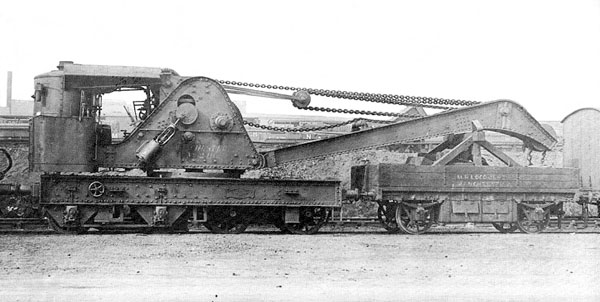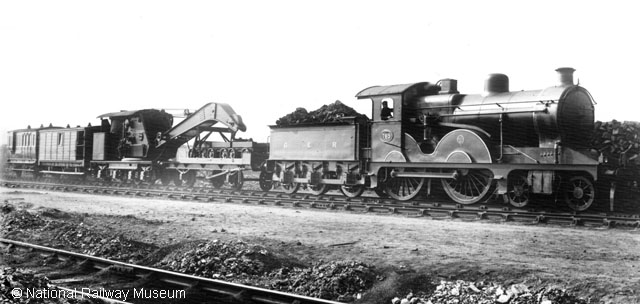
Historical Background
The First Breakdown Cranes on the British Railway System
In the very earliest days of the British railway system, locomotives and other items of rolling stock were light enough that any derailment or other accident could normally be attended to without assistance from a crane. The time was soon to come, however, for purpose-built railway breakdown cranes to be essential for keeping the railways running. The story of the breakdown crane, spanning more than 150 years, starts here…
The breakdown crane, or “accident crane” as it was more generally known until circa the Great War, was a development of the travelling hand crane which had come into use in the 1850s for goods yard and civil engineering work. In 1853, the Great Northern Railway ordered their first “accident crane" from Kirkstall Forge Co, for stabling at Peterborough; this crane being hand powered and of 8 tons capacity. It is notable that, though steam power for travelling cranes appeared in the 1860s, hand powered breakdown cranes were not totally dispensed with until implementation of the Modernisation Plan in the 1950s.
In his book “Railway Steam Cranes”, John S. Brownlie commented that: “Powerful hand cranes, aided by a gang of about 450 men, were used at the Welwyn accident in 1866”. Brownlie presumed that one of these cranes was that which the Great Northern Railway had provided in 1858 for the main line “following the use by the Midland Railway of its new Bedford-London connection”. This travelling crane cost £265 and, with an old van converted to a support vehicle at a cost of £90, was stationed at Hitchin so as to avoid delays caused by having to call on the Peterborough or London cranes.
The first steam powered “accident cranes” were built by Appleby Bros in 1875. Five two-axle cranes of 5-tons capacity were built for the Midland Railway, followed by two three-axle cranes of 10-tons capacity for the London & South Western Railway.

Steam powered Appleby Bros 5-ton accident crane of 1875
In 1886 the Caledonian Railway received from Cowans Sheldon two four-axle 15-ton cranes, these being the largest capacity breakdown cranes of the time. This was followed by orders for similar cranes from the Highland Railway (1887), the Glasgow & South Western Railway (1893), the Midland Railway (four built in 1893, another four in 1899 and a ninth in 1903) and many others.

Cowans Sheldon 15-ton crane, built for the Midland Railway in 1899
Most other major railways began ordering steam breakdown cranes in the late-1880s and 1890s, often of only 10 or 12 tons capacity. A notable exception was the London & North Western Railway whose Mr Webb preferred the use of hand cranes and hauling and/or jacking for re-railing. Having borrowed the Midland Railway’s 1893 Stoke-based steam crane on a number of occasions, mainly for permanent way work, Webb did eventually decide that the LNWR needed its own breakdown crane and he had one of 20 tons capacity built under his auspices at Crewe. Construction of this crane commenced in 1897 but didn’t reach completion until 1905, two years after Webb’s retirement, and by all accounts it was not a good example. It was sidelined in 1915 as the result of an accident when lifting a large loco and was sold to the War Department in 1916 for overseas military work, becoming available for sale in the UK again in 1921 and 1926.
The Great Eastern was another railway to build its own breakdown cranes, the first being a hand crane of 10-12 tons capacity built in-house in 1885 and converted to steam in 1895. The company then bought three of similar capacity from Cowans Sheldon in the 1890s before designing and building two 20-tonners at their Stratford works in 1907-1908 under the guidance of James Holden. These 20-ton cranes were novel in having hydraulic controls and were quite usable, though no doubt they were a little daunting to operate for those not familiar with the control system. The engines were uni-directional with a pump charging hydraulic accumulators.

1907 GER Stratford-built 20-ton crane. The loco is a GER class T19, LNER class D13
The Great Western Railway was a little tardy in going over to steam breakdown cranes, its first being three Cowans Sheldon 15-ton cranes built in 1900/1901 followed by two 20-ton cranes from the same maker in 1903. However the GWR quickly made up lost ground and became the UK leader in heavy, long jib, breakdown cranes with orders for two five-axle cranes of 36 tons capacity, the first built in 1908 by Ransomes & Rapier (GWR No. 2, the story of which may be found in the Selected Chronicles section of this website) and the second built in 1909 by Stothert & Pitt (GWR No. 1). A further Ransomes & Rapier 36-ton crane (GWR No. 3) followed in 1912.

GWR Nos. 1 & 2 lifting the 97-ton Great Bear at Swindon in 1909
